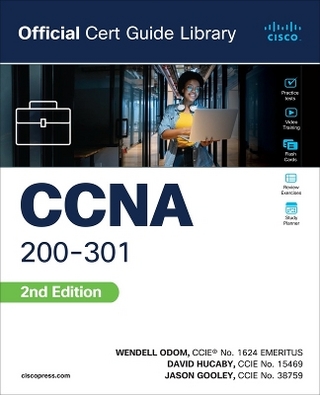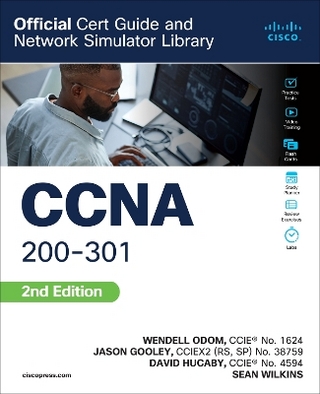
Absolute Beginner's Guide to A+ Certification
Que Corporation,U.S.
978-0-7897-3062-6 (ISBN)
- Titel ist leider vergriffen;
keine Neuauflage - Artikel merken
Passing a test is one thing...mastering the field is another, and this book is the first step to mastering the world of PC hardware and operating systems. Mark Edward Soper not only shows you what you need to pass the tests, but also what you need to have an edge on the competition, on exam day and in the workplace. Each chapter takes a ground-up approach, starting with the essentials and gradually building to larger, more complex concepts. The book is loaded with informative illustrations, photos and screen captures that help you follow along, even if you don't have all the hardware at home.
The CD accompanying the book provides study resources, including a PrepLogic test engine, lab exercises, and study notes. The book also offers a handy objectives index that maps each test objective to the section of the book in which it is covered. This invaluable - and overlooked by competitors - tool helps you to be certain that you are ready for test day!
Mark Edward Soper is president of Select Systems and Associates, Inc., a technical writing and training organization located in Evansville, Indiana. Get more information at the Select Systems Web site at www.selectsystems.com. Mark is a 20-year veteran of the computer industry whose first technical articles appeared in the late 1980s. Mark has written more than 140 articles on topics ranging from computer upgrades to laser printer tips and tricks, Internet access, and new features in Windows for publications such as Maximum PC, PCNovice/SmartComputing Guides, PCNovice, SmartComputing, the PCNovice/SmartComputing Learning Series, WordPerfect Magazine, The WordPerfectionist, and PCToday. Mark has taught computer troubleshooting and other technical subjects to thousands of students from Maine to Hawaii since the early 1990s. He is an A+ Certified hardware technician and a Microsoft Certified Professional. This is the second book Mark has written in the Absolute Beginner's Guide series: He is also the author of Absolute Beginner's Guide to Cable Internet Connections. Mark is also the author of Que's PC Help Desk in a Book. Mark has also written for other publishers in the Pearson Education family, including the recent TechTV's Upgrading Your PC, Second Edition for Peachpit/TechTV Press (http://www.peachpit.com) and The Complete Idiot's Guide to High-Speed Internet Connections for Alpha Books. Mark is the coauthor of Que's Upgrading and Repairing PCs: Field Guide and its predecessors (the Technician's Portable Reference series) and he has also contributed to many other Que books in this series, including Upgrading and Repairing PCs from the 11th Edition to the current 15th Anniversary Edition; Upgrading and Repairing Networks, Second Edition; Upgrading and Repairing Laptop Computers; and Upgrading and Repairing PCs, 12th Edition, Academic Edition. Mark has also contributed to several volumes in Que's Special Edition series, including: Special Edition Using Windows Millennium; Special Edition Using Windows XP Home Edition; Special Edition Using Windows XP Home Edition, Bestseller Edition; Special Edition Using Windows XP Professional; and Special Edition Using Windows XP Professional, Bestseller Edition. Mark is also a contributor to Platinum Edition Using Microsoft Windows XP. Watch for details about these and other book projects at the Que Web site at http://www.quepublishing.com. Mark welcomes comments at mesoper@selectsystems.com.
Introduction.
1. A+ Objectives for the 2003 Exam Revisions.
A+ Objectives for the 2003 Core Hardware Exam. A+ Objectives for the 2003 Operating Systems Exam.
2. PC Anatomy 101.
Hardware Overview. Software Overview. Firmware Overview. Memory: RAM and ROM. Dissecting Your Computer. The Outside Story of Typical Computers. Inside a Typical PC. Working Inside Your PC. The System BIOS. Hardware Resources. Study Lab.
3. How Computers Measure and Transfer Data.
Numbering Systems Used in Computers. Serial Versus Parallel Information Transfer. Study Lab.
4. The Motherboard and CPU.
The Motherboard. The CPU. Processor (CPU) Optimization. Study Lab.
5. Power Supplies and Circuit Testing.
Power Protection Types. Troubleshooting Power Problems. Study Lab.
6. BIOS and CMOS Configuration.
What Does the BIOS Control? System Configuration with the BIOS. Getting Support for Your BIOS. BIOS Upgrades. Study Lab.
7. RAM.
Memory Types and Forms. Memory Form Factors. Memory Banks. Installing SIMMs. Installing DIMMs and Rambus RDRAM Modules. Cache RAM and Main Memory. Study Lab.
8. Input/Output Devices and Cables.
Parallel Ports. Parallel Port Configuration. Serial Ports. USB Ports. Modems. Keyboards. Mouse and Pointing Devices. Audio Hardware and Sound Cards. IEEE-1394 (FireWire). Study Lab.
9. Video.
The Video Card and Monitor. Video Memory. Common Video Card Bus Types. Installing a Video Card. Adjusting Video Displays. Study Lab.
10. Printers.
The Printing Process. Dot-Matrix Printers. Inkjet Printers. Laser and LED Printers. Thermal Printers. Dye-Sublimation Printers. Solid-Ink Printers. Installing Firmware and Software Drivers. Study Lab.
11. Installing and Configuring Common Peripherals.
Interfaces Used for Common Peripherals. Connecting Digital Cameras to Your PC. Connecting DV Camcorders to Your PC. Connecting PDAs and Pocket PCs to Your PC. Connecting Network Devices to Your PC. Study Lab.
12. Portables.
Major Components of Typical Portable Computers. LCD Display. Input Devices. Power Sources. PC Card (PCMCIA Card) Types and Usage. Mini-PCI Card Types and Usage. Using the Proprietary Expansion Bus. Portable Storage. Infrared Ports. Memory. Selecting Upgrades for a Portable Computer. Study Lab.
13. Safety and Recycling.
Recycling and Disposal Issues. How to Read an MSDS (Material Safety Data Sheet). Electro-Static Discharge (ESD). Hazards. Study Lab.
14. Storage.
Common Characteristics of Magnetic Storage Devices. Floppy Disk Drives and Media. IDE/ATA Hard Disks. SCSI Interface. CD-ROM, CD-RW, and DVD Drives. Removable-Media and Tape Drives. External Hard Drives. Study Lab.
15. Preparing Hard and Floppy Drives with Windows.
Creating a Boot Disk Suitable for Hard Disk Preparation. Understanding File Systems and Partition Types. Preparing a Hard Disk for Use with Windows 9x/Me. Preparing a Hard Disk for Use with Windows NT/2000/XP. Using Format with Floppy and Hard Disks. Troubleshooting Drive Preparation Problems. Study Lab.
16. Operating System Installation.
Clean Installation Versus Dual-Boot Installation. Making Sure Your System Is Ready for a Particular Windows Version. Obtaining Compatible Drivers for Your Version of Windows. Additional Preparations for Installation. Backing Up Existing Data and Settings. Using an Upgrade Version of Windows for a New Installation. Determining Installation Options. Installing Windows 9x/Me. Installing Windows NT 4.0. Installing Windows 2000 Professional or XP. Installing Windows 2000 or XP from a Disk Image and Updating the SID. Installing Windows from a Recovery CD. Restoring User Data Files. Troubleshooting Your Installation. Study Lab.
17. Operating System Upgrades.
Upgrading to Windows 98. Upgrading to Windows 2000 Professional. Upgrading to Windows XP Professional. Study Lab.
18. Using and Optimizing Windows.
Windows 9x/Me Boot Sequence. Adjusting Default Memory Configurations (Windows 9x). Win.com in Windows 9x. Windows 9x/Me Registry. Win.ini and System.ini in Windows 9x/Me. Comparing Windows 9x/Me with Windows NT/2000/XP. Using the Windows GUI. Disk Management. File Management. Using Command-Prompt Functions and Utilities. Optimizing Windows. Study Lab.
19. Installing and Configuring Hardware in Windows.
Printing and Printer Configuration. Installing and Configuring Hardware. Troubleshooting Hardware. Study Lab.
20. Troubleshooting Windows and Windows Applications.
Startup Errors for Windows 9x/Me. Startup Errors for Windows NT 4.0/2000/XP. Operating System Error Messages and Solutions. Swapfile (Paging File) and Hard Disk Access Problems. Drive Configuration Errors. Post-Startup Errors. Using Windows Utilities for Troubleshooting. Computer Viruses. Study Lab.
21. Networking and Internet Connectivity.
Network Models. Internet Connectivity Technologies. Network Protocols. TCP/IP Applications and Technologies. Network Topologies. Network Types. Cable and Connector Types. Installing Network Interface Cards. Configuring Network Interface Cards. Switches and Hubs. Beyond LANs-Repeaters, Bridges, and Routers. Networking Configuration. Setting Up Shared Resources. Setting Up the Network Client. Using Shared Resources. Browser Installation and Configuration. Using Network Command-Line Tools. Study Lab.
Appendix A: CD-ROM Instructions.
Using PrepLogic Practice Exams, Preview Edition Software. Software Requirements. Installing PrepLogic Practice Exams, Preview Edition. Using PrepLogic Practice Exams, Preview Edition. Getting More Exams. Using Chapters 22 and 23. Using the CD Supplement. Windows Command Reference. Using the Study Guide. Using the Hands-On Labs. Using the Beep Codes.
Index.
Elements on CD.
Chapter 22. Troubleshooting Principles. Chapter 23. Preparing to Take the A+ Certification Exams. Appendix B: Glossary. Appendix CD Supplement. Windows Command Reference.
| Erscheint lt. Verlag | 4.3.2004 |
|---|---|
| Sprache | englisch |
| Gewicht | 1470 g |
| Themenwelt | Mathematik / Informatik ► Informatik ► Theorie / Studium |
| Informatik ► Weitere Themen ► Zertifizierung | |
| ISBN-10 | 0-7897-3062-6 / 0789730626 |
| ISBN-13 | 978-0-7897-3062-6 / 9780789730626 |
| Zustand | Neuware |
| Haben Sie eine Frage zum Produkt? |
aus dem Bereich


